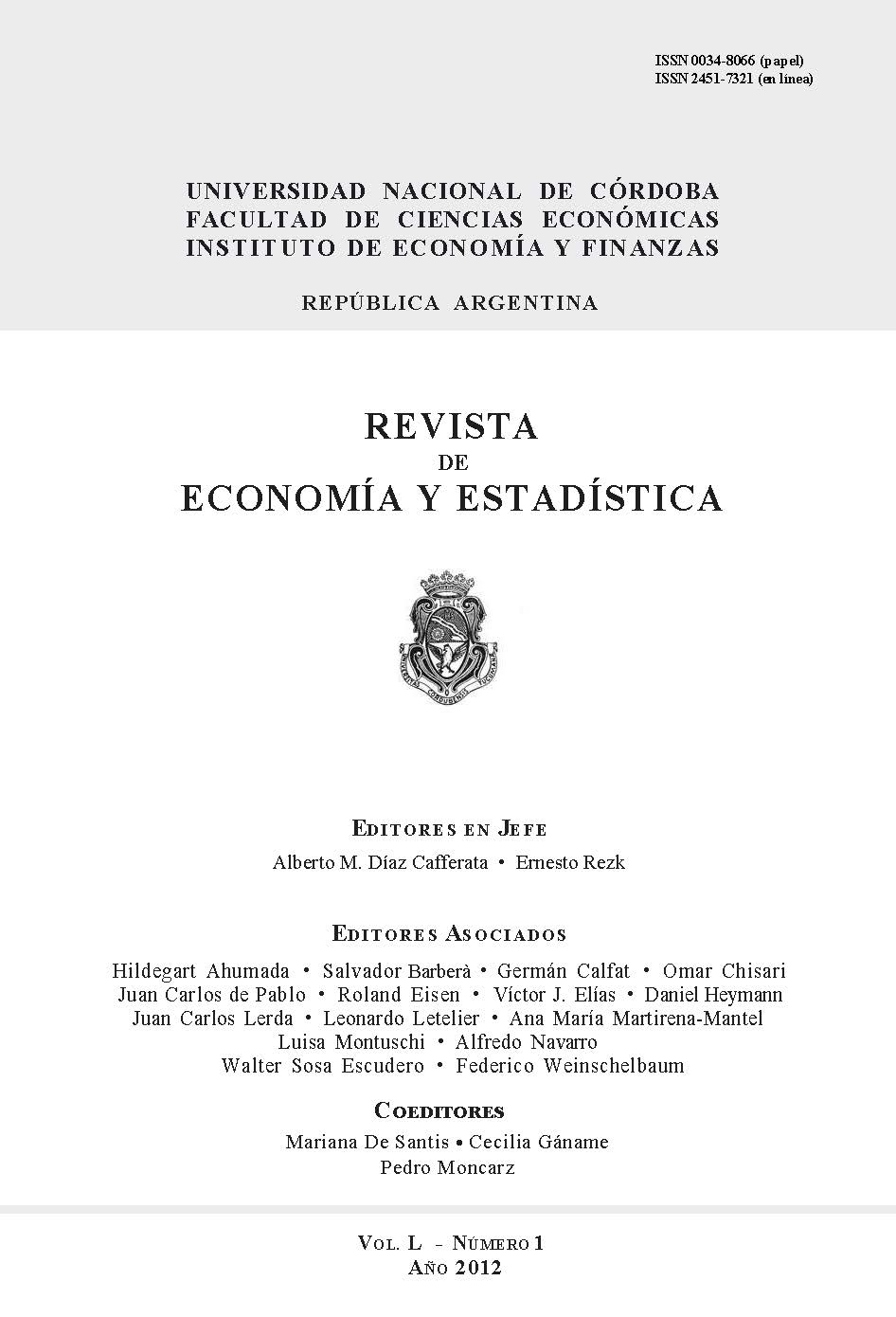Elasticity of demand for labor in Uruguay
DOI:
https://doi.org/10.55444/2451.7321.2012.v50.n1.10252Keywords:
labour demand, long-run elasticities, cointegration, VECMAbstract
The objective of this research is to estimate the long-run elasticities of labour demand for Uruguay (1986-2005). The elasticities were estimated using Johansen cointegration analysis and the vector error correction model. We found that the aggregate labour demand is relatively inelastic with respect to changes in labour cost and more elastic when the universe is bounded to private dependent work. It’s close to unity with respect to product and the response of labour demand to change in capital cost seems to be the same as the response to change in labour cost with opposite sign.
Downloads
References
Allen, S., Cassoni, A.y Labadie, G. (2004). “Unions and employment in Uruguay” Capítulo en: Heckman, J. y Pages, C. (editors). Law and Employment: Lessons from Latin America and the Caribbean. National Bureau of Economic Research. Págs. 435-496.
Amarante, V. (2000) “La elasticidad producto-empleo de largo plazo en Uruguay”. Instituto de Economía, Facultad de Ciencias Económicas y de Administración, Universidad de la República. Documento de trabajo 6/00.
Bernal, R. y Cardenas, M. (2003). “Determinants of labor demand in Colombia: 1976-1996” National Bureau of Economic Research. Working paper Nr. 10077.
Bucheli, M. (2004). “Uruguay: La cobertura de la seguridad social en el empleo, 1991-2002”. En Protección social y mercado laboral, Fabio Bertranou (editor). Santiago de Chile, Oficina Internacional del Trabajo.
Bustos, A., Engel, E. y Galetovic, A. (1998) “Impuestos y Demanda por Capital en Chile, 1985-1995.” Mimeo, Centro de Economía Aplicada, Departamento de Ingeniería Industrial, Universidad de Chile.
Cassoni, A. (1999.a) “Labour demand in Uruguay before and after re-unionisation”. Departamento de Economía, Facultad de Ciencias Sociales, Universidad de la República. Documento 1/99
Cassoni, A. (1999.b) “The wage elasticity of labour demand in the Uruguayan manufacturing sector after re-unionisation: new results”. Departamento de Economía, Facultad de Ciencias Sociales, Universidad de la República. Documento 14/99.
Enders, W. (1995) Applied Econometric Time Series. John Wiley & Sons., Iowa.
Hamermesh, D. (1988), “Data difficulties in labor economics”. National Bureau of Economic Research. Working paper Nr. 2622.
Hamermesh, D. (1993) La demanda de trabajo. Traducción al español de García de Paso, José, publicada por el Ministerio de Trabajo y Seguridad Social, España (1995). Título original: Labor demand. Princeton University Press.
Hamermesh, D. (2004) “Labor demand in Latin America and the Caribbean: What does it tell us?”. Capítulo en: Heckman, J. y Pages, C. (editors). Law and Employment: Lessons from Latin America and the Caribbean. National Bureau of Economic Research. Págs. 553-562.
Isaza, J. y Meza, C. (2004) “Cambios estructurales de la demanda de trabajo en Colombia: un análisis entre 1984-I y 2000-IV”. Universidad de La Salle, Departamento de Investigaciones, Bogotá, D.C.
Martínez C., Morales G. y Valdés, R. (2001) “Cambios estructurales en la demanda por trabajo en Chile”. Economía Chilena. Banco Central de Chile, Vol. 4, Nº 2.
Montoya, S. y Navarro, L. (1996) “La demanda de trabajo en Argentina”. Publicación disponible en www.aaep.org.ar, Asociación Argentina de Economía Política. Publicación original: “La demanda de trabajo en Argentina: teoría. Aplicación y evaluación de una política”, Revista Estudios, Fundación Mediterránea, IERAL Nº 78, Año XIX.
Pessino, C. y Gill, I. (1996) "Determinants of labor demand: estimating the benefits of labor policy reform”. U.C.E.M.A., Documento de trabajo Nº 114.
Rojas, P. (1987) ”Un análisis empírico de la demanda por trabajo en Chile 1977-1985”. Cuadernos de Economía, Año 24, Nº 77, pp. 77-97.
Varian, H. (1992) Análisis Microeconómico, 3ª Edición. Antoni Bosch, editor, S.A.
Downloads
Published
Issue
Section
License
Copyright (c) 2012 Sylvina Porras, Eliana Melognio

This work is licensed under a Creative Commons Attribution-NonCommercial-NoDerivatives 4.0 International License.
Authors who have publications with this journal agree to the following terms:
Authors retain their copyright and grant the journal the right of first publication of their work, which is simultaneously subject to the Creative Commons Attribution-NonCommercial-NoDerivatives 4.0 International License that allows third parties to share the work provided that its author and first publication in this journal are indicated.
Authors may adopt other non-exclusive licensing arrangements for distribution of the published version of the work (e.g. depositing it in an institutional telematic archive or publishing it in a monographic volume) as long as the initial publication in this journal is indicated.
Authors are allowed and encouraged to disseminate their work via the Internet (e.g. in institutional telematic archives or on their website) before and during the submission process, which can lead to interesting exchanges and increase citations of the published work. (See The Open Access Effect)














